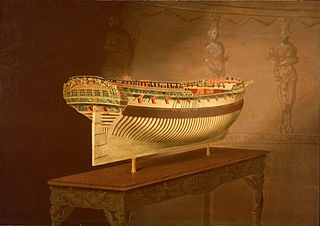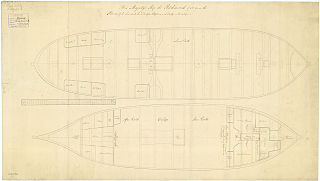
HMS Enterprise was a 28-gun sixth-rate Enterprise-class frigate of the Royal Navy. She was the name ship of her class of twenty-seven ships.

HMS Tartar was a 28-gun sixth-rate frigate of the Royal Navy.

HMS Lark was a 32-gun Richmond-class frigate fifth-rate frigate of the Royal Navy. She was launched in 1762 and destroyed in Narragansett Bay in 1778, during the American Revolutionary War.

HMS Yarmouth was a 64-gun third rate ship of the line of the Royal Navy, designed and built by Joseph Allin the younger at Deptford Dockyard. She was previously ordered to the dimensions specified in the 1741 proposals for modifications to the 1719 Establishment, but the Admiralty had very quickly concluded that these were too small, and as an experiment in 1742 authorised an addition of 6 ft to the planned length, and Yarmouth was re-ordered to the enlarged design in June 1742. She was built at Deptford, where the Admiralty felt they could best observe the effectiveness of the added size, and launched on 8 March 1745.

HMS Winchelsea was a 32-gun fifth-rate Niger-class frigate of the Royal Navy, and was the sixth Royal Navy ship to bear this name. She was ordered during the Seven Years' War, but completed too late for that conflict. She cost £11,515-18-0d to build.

HMS Carysfort was a 28-gun Coventry-class sixth-rate frigate of the Royal Navy. She served during the American War of Independence, the French Revolutionary and the Napoleonic Wars in a career that spanned over forty years.

HMS Surprise was a 28-gun Enterprise-class sixth-rate frigate of the Royal Navy, which served throughout the American Revolutionary War and was broken up in 1783.

HMS Aurora was a 28-gun Enterprise-class sixth-rate frigate of the Royal Navy, that saw service during the American and French Revolutionary wars, and the Napoleonic Wars. Designed to carry a complement of 200 men, she was armed with a main battery of twenty-four 9-pound guns.
HMS Andromeda was a 28-gun Enterprise-class sixth-rate frigate of the Royal Navy. Andromeda was first Royal Navy ship commissioned by that name, in September 1777 under the command of Captain Henry Byrne. On 30 May 1778 she captured and burned American privateer brig Angelica at sea while transporting General Sir William Howe back to England. It sank off Martinique in the Great Hurricane of 1780 on 11 October 1780, killing all of the crew.

HMS Mermaid was a Mermaid-class sixth-rate frigate of the Royal Navy. She was first commissioned in April 1761 under Captain George Watson and built in Blaydes Yard in Kingston-Upon-Hull.
HMS Greyhound was a modified Royal Navy Mermaid-class sixth-rate frigate. She was first commissioned in October 1775 under Captain Archibald Dickson.
HMS Triton was a modified Mermaid-class sixth-rate 28-gun frigate of the Royal Navy.
HMS Boreas was a modified Mermaid-class sixth-rate frigate of the Royal Navy. She was first commissioned in August 1775 under Captain Charles Thompson. She was built at Blaydes Yard in Hull to a design by Sir Thomas Slade at a cost of £10,000. She was fitted out at Chatham Docks.

HMS Juno was a 32-gun Richmond-class fifth-rate frigate of the Royal Navy. She was launched in 1757 and served throughout the American Revolutionary War until scuttled in 1778 to avoid capture. On 5 June, 1777 she, HMS Juno, and HMS Orpheus recaptured privateer brig "Lucy" 15 Leagues off Nantucket. On 9 July, 1777 she captured Betsy in Boston Bay. On 9 January, 1778 she captured French snow David 3-4 miles off the north east tip of Block Island. She engaged USS Providence during Providence's escape from Providence, Rhode Island 30 April 1778.

HMS Richmond was the name ship of the six-vessel, 32-gun Richmond-class fifth-rate frigates of the Royal Navy. She was launched in 1757 and served throughout the American Revolutionary War. She and HMS Emerald captured French brig Alexandrine in Chesapeake Bay off the mouth of the Rappahannock River 3 January, 1778. She captured 1 prize off Cape Charles in February, 1778. On 5 February a sloop ran aground off Cherry Point while being pursued by Richmond and HMS Solebay and was burned. On 9 February Richmond and HMS Solebay captured Maryland State Govt. trading vessel Lydia off St. Mary's River, later ruled a recapture. On 28 February she captured Danish flagged, American owned ship Good Hope off Cape Henry. She was captured by the French 74-gun Bourgogne and the frigate Aigrette on 11 September 1781 in the Chesapeake. She then served as Richemont under Lieutenant Mortemart.

HMS Southampton was the name ship of the 32-gun Southampton-class fifth-rate frigates of the Royal Navy. She was launched in 1757 and served for more than half a century until wrecked in 1812.

HMS Venus was the name ship of the 36-gun Venus-class fifth-rate frigates of the Royal Navy. She was launched in 1758 and served for more than half a century until 1809. She was reduced from 36 to 32 guns in 1792. She was sold in 1822.

HMS Pallas was one of the three 36-gun Venus-class fifth-rate frigates of the Royal Navy. She was launched in 1757 and initially served in Sir Edward Hawke's fleet blockading the coast of France where she fought at the Raid on Cherbourg and in the Battle of Bishops Court. She later served for a number of years in the Mediterranean Sea before moving to serve off the coast of Africa between 1774 and 1776 where she protected the isolated British colonies. In 1778 she joined the Newfoundland Station and participated in the attack on Saint Pierre and Miquelon. Pallas returned to the English Channel after this and assisted in destroying a French invasion force intended for the Channel Islands in 1779 before briefly serving on the Jamaica Station. In 1783 she was beached on São Jorge Island after she was found to be heavily leaking; she was burned there on 24 February.

HMS Maidstone was a 28-gun Coventry-class sixth-rate frigate of the Royal Navy. She was launched in 1758 and taken to pieces in 1794.

HMS Milford was a 28-gun Coventry-class sixth-rate frigate of the Royal Navy. She was built at Milford by Richard Chitty and launched in 1759. She was sold for breaking at Woolwich on 17 May 1785.
This page is based on this
Wikipedia article Text is available under the
CC BY-SA 4.0 license; additional terms may apply.
Images, videos and audio are available under their respective licenses.















